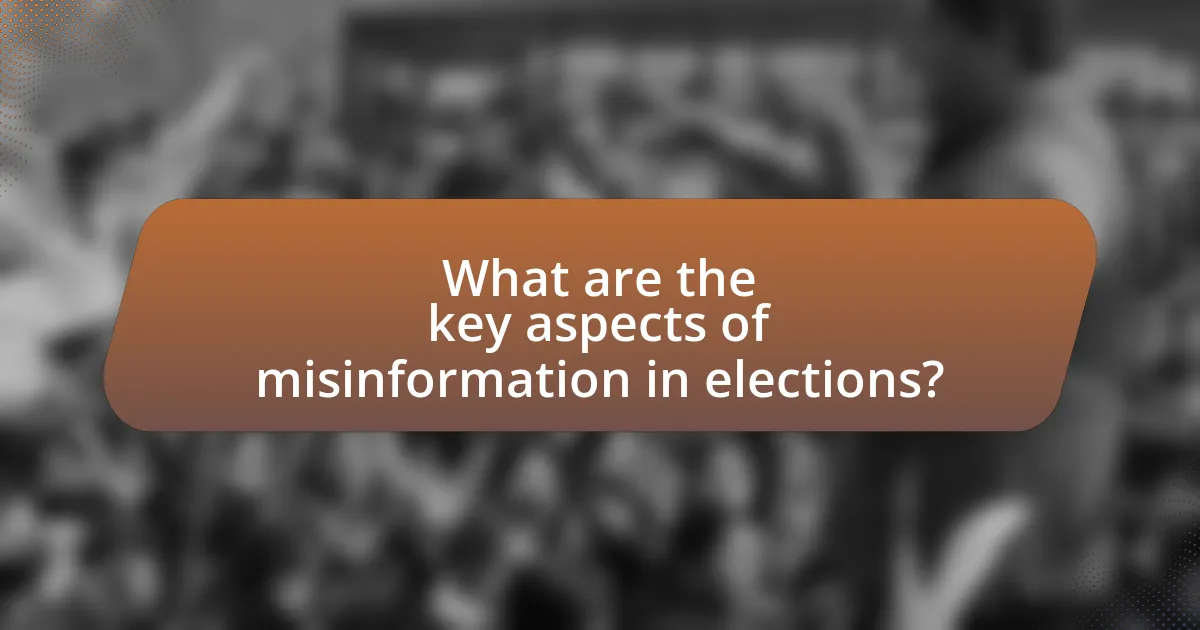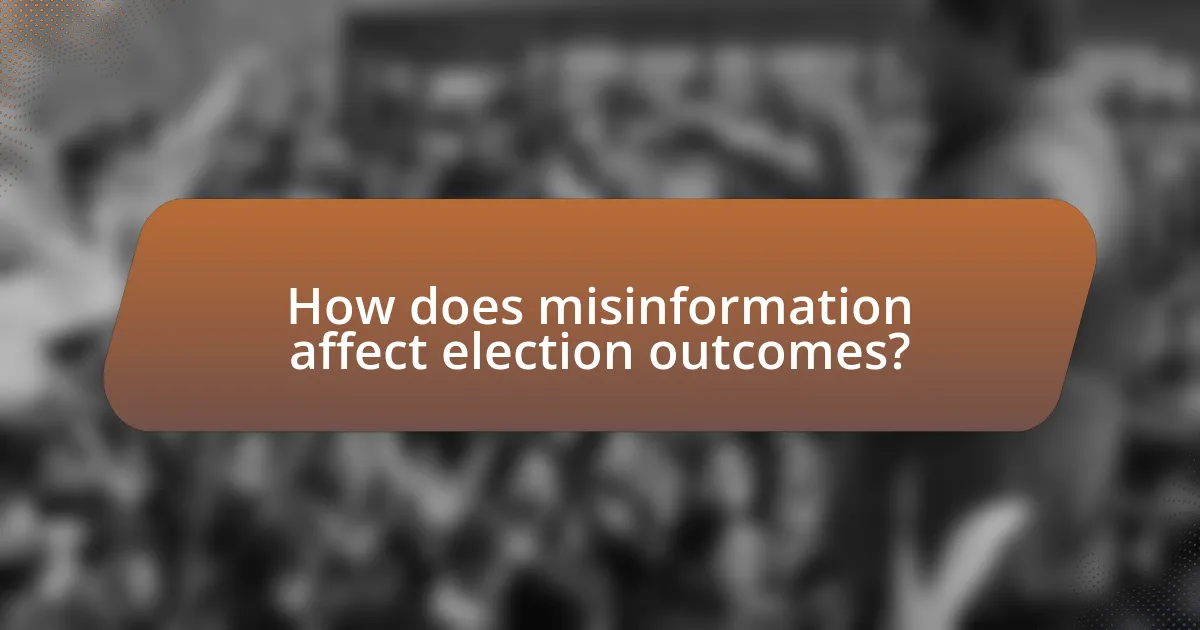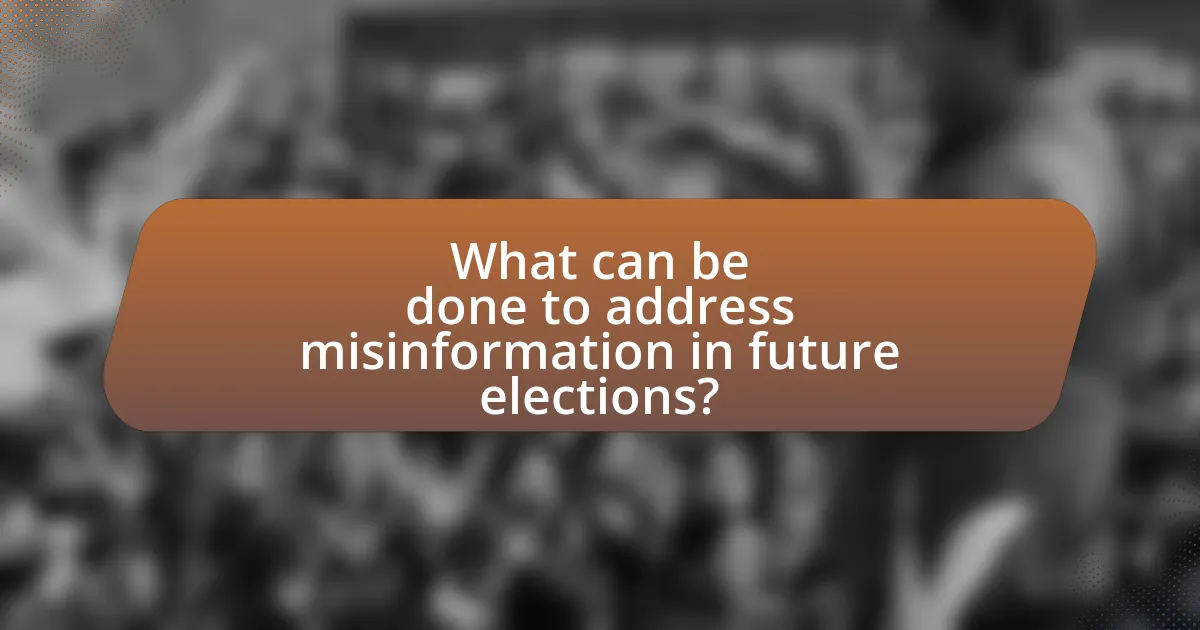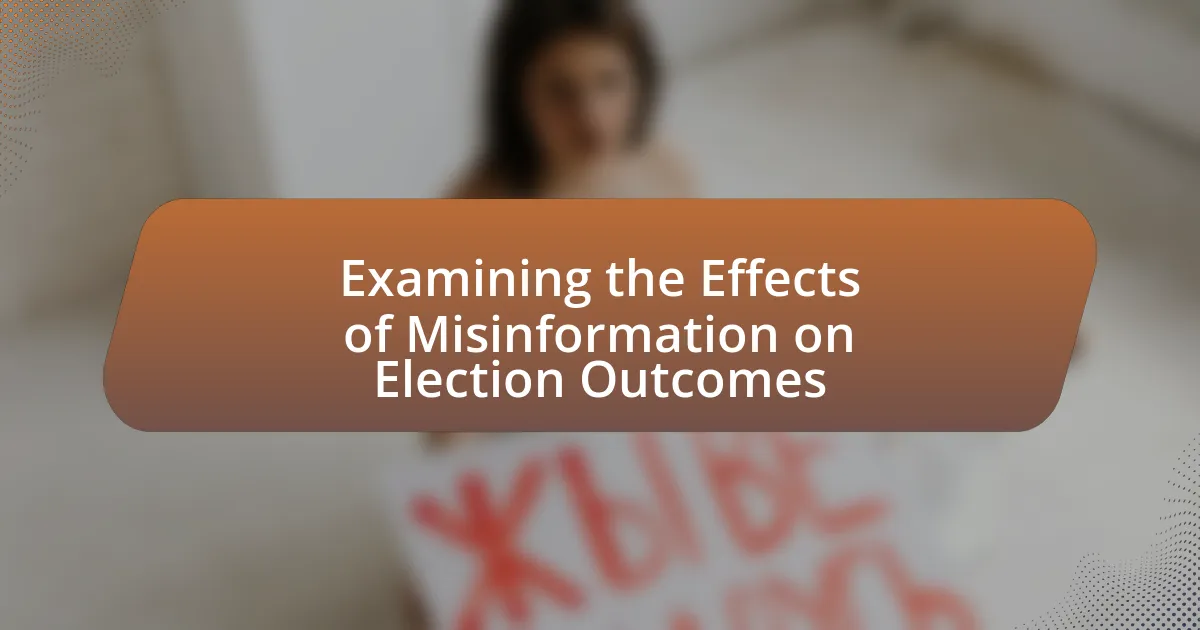The article examines the effects of misinformation on election outcomes, highlighting key aspects such as the spread of false information, manipulation of public perception, and erosion of trust in electoral processes. It discusses how misinformation proliferates through social media and traditional media, influencing voter behavior and perceptions. The article also explores the psychological factors that make voters susceptible to misinformation, the types of misinformation commonly encountered, and the distinction between misinformation and disinformation. Furthermore, it addresses the consequences of misinformation on democratic processes, strategies to mitigate its effects, and the collaborative efforts necessary among governments, tech companies, and civil society to combat this issue effectively.

What are the key aspects of misinformation in elections?
The key aspects of misinformation in elections include the spread of false information, manipulation of public perception, and the undermining of trust in electoral processes. False information can originate from various sources, including social media, political campaigns, and foreign interference, leading to confusion among voters. Research indicates that misinformation can significantly influence voter behavior; for instance, a study by the Pew Research Center found that 64% of Americans believe fabricated news stories cause confusion about the basic facts of current events. Additionally, misinformation can erode trust in institutions, as evidenced by a 2020 report from the Knight Foundation, which highlighted that exposure to misinformation correlates with decreased confidence in election integrity. These aspects collectively demonstrate the detrimental impact of misinformation on democratic processes and election outcomes.
How does misinformation spread during election cycles?
Misinformation spreads during election cycles primarily through social media platforms, where false narratives can quickly gain traction among users. Research indicates that misinformation is often amplified by algorithms that prioritize engagement, leading to wider dissemination of misleading content. For instance, a study by the Massachusetts Institute of Technology found that false news stories are 70% more likely to be retweeted than true stories, highlighting the rapid spread of misinformation. Additionally, during elections, targeted advertising and coordinated disinformation campaigns further exacerbate the issue, as seen in the 2016 U.S. presidential election, where foreign entities exploited social media to influence voter perceptions.
What role do social media platforms play in disseminating misinformation?
Social media platforms play a significant role in disseminating misinformation by enabling rapid sharing and amplification of false information among users. The architecture of these platforms, which prioritizes engagement and virality, often leads to the spread of sensational or misleading content over factual reporting. For instance, a study by the Pew Research Center found that 64% of Americans believe that social media has a major role in the spread of misinformation, particularly during election cycles. This environment allows misinformation to reach vast audiences quickly, influencing public perception and potentially swaying electoral outcomes.
How do traditional media contribute to the spread of misinformation?
Traditional media contribute to the spread of misinformation by prioritizing sensationalism and speed over accuracy. This often leads to the dissemination of unverified information, as seen in instances where breaking news is reported without thorough fact-checking. For example, during the 2016 U.S. presidential election, numerous traditional media outlets aired unverified claims about candidates, which were later debunked but had already influenced public perception. Additionally, the reliance on expert opinions and sources that may not be credible can further propagate false narratives, as evidenced by studies showing that misleading headlines attract more attention than accurate ones, thereby amplifying misinformation.
Why is misinformation particularly impactful in elections?
Misinformation is particularly impactful in elections because it can significantly distort public perception and influence voter behavior. During elections, individuals often rely on social media and other platforms for information, making them susceptible to false narratives. Research indicates that misinformation can lead to decreased trust in legitimate sources, as seen in the 2016 U.S. presidential election, where false information spread rapidly online, affecting voter opinions and decisions. Furthermore, studies show that misinformation can create polarization among voters, leading to increased division and conflict within the electorate. This manipulation of information ultimately undermines the democratic process by skewing the electorate’s understanding of candidates and issues.
What psychological factors make voters susceptible to misinformation?
Voters are susceptible to misinformation due to cognitive biases, emotional responses, and social influences. Cognitive biases, such as confirmation bias, lead individuals to favor information that aligns with their pre-existing beliefs, making them more likely to accept false information that supports their views. Emotional responses, particularly fear and anger, can amplify the impact of misinformation, as emotionally charged messages are more memorable and persuasive. Additionally, social influences, including groupthink and the desire for social acceptance, can pressure voters to adopt misinformation shared within their social circles. Research by Lewandowsky et al. (2012) highlights how these psychological factors contribute to the spread and acceptance of misinformation, demonstrating that individuals are often unaware of their susceptibility to false information.
How does misinformation influence voter perceptions and decisions?
Misinformation significantly influences voter perceptions and decisions by shaping beliefs and attitudes about candidates and policies. Studies have shown that exposure to false information can lead to misinformed voters who may support candidates based on inaccurate narratives. For instance, research published in the journal “Political Communication” by Vosoughi, Roy, and Aral (2018) found that false news stories were 70% more likely to be retweeted than true stories, indicating a higher engagement with misinformation. This engagement can distort public opinion, leading to polarized views and potentially swaying election outcomes.
What types of misinformation are commonly encountered in elections?
Common types of misinformation encountered in elections include false information about candidates, misleading claims about voting procedures, and fabricated statistics regarding voter turnout. False information about candidates often involves distorted facts about their policies or personal lives, which can influence public perception and voting behavior. Misleading claims about voting procedures, such as incorrect deadlines or eligibility requirements, can create confusion and discourage voter participation. Fabricated statistics regarding voter turnout can be used to manipulate public opinion about the legitimacy of an election, as seen in various studies highlighting the impact of misinformation on electoral outcomes.
What are the differences between disinformation and misinformation?
Disinformation is intentionally false information spread to deceive, while misinformation is false information shared without the intent to mislead. Disinformation is often used strategically in contexts like political campaigns to manipulate public opinion, as seen in various election interference cases. Misinformation, on the other hand, can arise from misunderstandings or misinterpretations, such as sharing incorrect statistics without malicious intent. The distinction lies primarily in the intent behind the information’s dissemination.
How do false narratives and conspiracy theories affect electoral outcomes?
False narratives and conspiracy theories significantly distort electoral outcomes by influencing voter perceptions and behaviors. Research indicates that misinformation can lead to decreased trust in electoral processes, as seen in the 2016 U.S. presidential election, where false claims about voter fraud were widely circulated, resulting in a substantial portion of the electorate questioning the legitimacy of the election. Additionally, studies show that exposure to conspiracy theories can polarize voters, pushing them towards extreme positions and reducing their likelihood of engaging in constructive political discourse. This manipulation of public opinion can ultimately sway election results, as evidenced by the impact of social media platforms in disseminating misleading information during critical electoral periods.

How does misinformation affect election outcomes?
Misinformation significantly affects election outcomes by influencing voter perceptions and behaviors. Studies indicate that exposure to false information can lead to decreased voter turnout, altered voting preferences, and increased polarization among the electorate. For instance, a 2017 study published in the journal “Nature” found that misinformation spread through social media platforms can sway public opinion and create confusion about candidates and policies. Additionally, research from the Pew Research Center shows that 64% of Americans believe fabricated news stories cause a great deal of confusion about the basic facts of current events, which can directly impact electoral decisions.
What evidence exists linking misinformation to voter behavior?
Evidence linking misinformation to voter behavior includes studies demonstrating that exposure to false information can significantly alter voting intentions and decisions. For instance, research conducted by the Pew Research Center found that 64% of Americans believe fabricated news stories cause confusion about basic facts, which can lead to misinformed voting choices. Additionally, a study published in the journal “Political Communication” by Allcott and Gentzkow in 2017 quantified the impact of misinformation on the 2016 U.S. presidential election, revealing that misinformation on social media influenced voter preferences and turnout. These findings illustrate a clear connection between misinformation and changes in voter behavior, highlighting the potential for misinformation to sway electoral outcomes.
How have past elections demonstrated the effects of misinformation?
Past elections have shown that misinformation significantly influences voter behavior and election outcomes. For instance, during the 2016 U.S. presidential election, studies indicated that false information spread through social media platforms affected public perception and voting decisions, with a Pew Research Center survey revealing that 64% of Americans believed fabricated news stories confused them about the facts. Additionally, the 2020 election saw the proliferation of misleading claims about mail-in voting, which contributed to voter suppression and distrust in the electoral process, as reported by the Brennan Center for Justice. These examples illustrate how misinformation can distort democratic processes and alter the trajectory of elections.
What studies have been conducted on misinformation’s impact on voter turnout?
Studies have shown that misinformation significantly impacts voter turnout. For instance, a study by Allcott and Gentzkow (2017) published in the Journal of Economic Perspectives found that exposure to false information can lead to decreased voter participation, particularly among specific demographic groups. Additionally, research by Vosoughi, Roy, and Aral (2018) in Science demonstrated that misinformation spreads faster and reaches more people than true information, which can create confusion and apathy among voters, ultimately affecting turnout rates. These studies provide concrete evidence that misinformation plays a detrimental role in influencing electoral engagement.
What are the consequences of misinformation on democratic processes?
Misinformation significantly undermines democratic processes by distorting public perception and influencing voter behavior. It can lead to the spread of false narratives that shape opinions and decisions, ultimately affecting election outcomes. For instance, a study by the Pew Research Center found that 64% of Americans believe fabricated news stories cause confusion about the basic facts of current events, which can skew voter understanding and engagement. Additionally, misinformation can erode trust in institutions, as seen during the 2016 U.S. presidential election, where false information circulated widely on social media, contributing to polarization and distrust among voters. This manipulation of information disrupts informed decision-making, essential for a functioning democracy.
How does misinformation undermine public trust in electoral systems?
Misinformation undermines public trust in electoral systems by creating doubt about the integrity and fairness of the electoral process. When false information circulates, it can lead voters to believe that elections are rigged or that their votes do not matter, which diminishes their confidence in the system. For instance, a study by the Pew Research Center found that 70% of Americans believe misinformation has a significant impact on public trust in elections. This erosion of trust can result in lower voter turnout and increased polarization, as individuals may feel disillusioned or skeptical about participating in the democratic process.
What long-term effects can misinformation have on political engagement?
Misinformation can lead to decreased political engagement over the long term. When individuals are exposed to false information, they may become disillusioned with the political process, believing that their participation has little impact. Research indicates that persistent misinformation can create a polarized electorate, where individuals align with extreme viewpoints, further alienating moderate voices and reducing overall civic participation. For example, a study by the Pew Research Center found that misinformation contributes to increased distrust in political institutions, which can diminish voter turnout and engagement in democratic processes.
What strategies can mitigate the effects of misinformation in elections?
To mitigate the effects of misinformation in elections, implementing fact-checking initiatives is essential. Fact-checking organizations, such as PolitiFact and FactCheck.org, actively verify claims made by candidates and political entities, providing voters with accurate information. Additionally, promoting media literacy programs can empower voters to critically evaluate sources and discern credible information from falsehoods. Research indicates that individuals exposed to media literacy training are better equipped to identify misinformation (Mihailidis & Viotty, 2017, “Media Literacy in a Post-Truth World,” Journal of Media Literacy Education). Furthermore, social media platforms can enhance their algorithms to flag or reduce the visibility of misleading content, as seen in efforts by Facebook and Twitter to combat misinformation during elections. These strategies collectively contribute to a more informed electorate and reduce the impact of false information on electoral outcomes.
How can fact-checking organizations help combat misinformation?
Fact-checking organizations help combat misinformation by verifying claims and providing accurate information to the public. These organizations analyze statements made by public figures, media outlets, and social media posts, assessing their truthfulness based on evidence and reliable sources. For instance, during the 2020 U.S. presidential election, organizations like FactCheck.org and PolitiFact played crucial roles in debunking false claims about voting processes and election integrity, which helped inform voters and reduce the spread of misleading information. By publishing their findings, fact-checking organizations not only clarify misconceptions but also promote media literacy, encouraging individuals to critically evaluate the information they encounter.
What role do educational initiatives play in reducing misinformation impact?
Educational initiatives play a crucial role in reducing the impact of misinformation by equipping individuals with critical thinking skills and media literacy. These initiatives help individuals discern credible information from falsehoods, thereby fostering informed decision-making. Research indicates that programs aimed at enhancing media literacy can significantly decrease susceptibility to misinformation; for instance, a study published in the Journal of Communication found that participants who underwent media literacy training were 50% less likely to believe false information compared to those who did not receive such training. By promoting awareness and understanding of misinformation tactics, educational initiatives empower citizens to engage more effectively in democratic processes, particularly during elections.

What can be done to address misinformation in future elections?
To address misinformation in future elections, implementing comprehensive media literacy programs is essential. These programs educate voters on how to critically evaluate information sources and recognize false narratives. Research indicates that media literacy can significantly reduce susceptibility to misinformation; for instance, a study by the Stanford History Education Group found that students who received media literacy training were better at identifying credible sources. Additionally, enhancing collaboration between social media platforms and fact-checking organizations can help identify and mitigate the spread of false information in real-time, as demonstrated by initiatives like Facebook’s fact-checking partnerships, which have been shown to reduce the visibility of misleading content.
How can technology be leveraged to combat misinformation?
Technology can be leveraged to combat misinformation through the development of advanced algorithms and tools that identify and flag false information in real-time. For instance, social media platforms utilize machine learning algorithms to analyze content and detect patterns indicative of misinformation, which can lead to the removal or labeling of such content. A study by the Pew Research Center found that 64% of Americans believe that social media companies should take more responsibility for preventing the spread of false information. Additionally, fact-checking organizations employ automated systems to verify claims and provide accurate information, thereby enhancing public awareness and trust. These technological interventions are crucial in maintaining the integrity of information, especially during critical periods like elections.
What tools are available for identifying and flagging misinformation?
Several tools are available for identifying and flagging misinformation, including fact-checking websites, social media monitoring tools, and AI-driven content analysis platforms. Fact-checking websites like Snopes and FactCheck.org provide verified information and debunk false claims. Social media monitoring tools such as CrowdTangle and Hoaxy track the spread of misinformation across platforms, allowing users to analyze trends and sources. AI-driven content analysis platforms, like Full Fact and ClaimBuster, utilize machine learning algorithms to assess the credibility of information in real-time. These tools collectively enhance the ability to detect and address misinformation effectively, especially in the context of election outcomes.
How can algorithms be improved to reduce the spread of false information?
Algorithms can be improved to reduce the spread of false information by incorporating advanced fact-checking mechanisms and enhancing user feedback systems. Implementing real-time fact-checking algorithms can help identify and flag false claims before they proliferate, as evidenced by studies showing that platforms utilizing such systems have seen a significant decrease in the sharing of misinformation. Additionally, algorithms can be adjusted to prioritize content from verified sources and incorporate user reporting features that allow users to flag misleading information, which can then be reviewed and acted upon. Research indicates that platforms that actively engage users in identifying misinformation can reduce its spread by up to 30%.
What best practices should voters adopt to navigate misinformation?
Voters should adopt the best practice of verifying information through credible sources to navigate misinformation effectively. This involves cross-referencing claims with established fact-checking organizations such as Snopes or FactCheck.org, which provide evidence-based assessments of the accuracy of various statements. Additionally, voters should be cautious of sensational headlines and consider the source’s credibility, as research indicates that misinformation often spreads through unreliable channels. For instance, a study by the MIT Media Lab found that false news stories are 70% more likely to be retweeted than true stories, highlighting the importance of discerning fact from fiction. Engaging in discussions with informed individuals and participating in community forums can also enhance understanding and reduce the impact of misinformation.
How can individuals verify the credibility of information sources?
Individuals can verify the credibility of information sources by assessing the author’s qualifications, checking for citations and references, and evaluating the publication’s reputation. For instance, credible sources often have authors with relevant expertise or academic credentials, which can be verified through professional profiles or institutional affiliations. Additionally, reputable publications typically provide citations to support their claims, allowing readers to trace the information back to original research or data. According to a study published in the Journal of Communication, individuals who cross-reference information with established databases and peer-reviewed journals are more likely to identify credible sources, thereby reducing the impact of misinformation, especially in contexts like election outcomes.
What steps can voters take to critically evaluate political messages?
Voters can critically evaluate political messages by verifying the sources of information, analyzing the evidence presented, and considering the context of the message. Verifying sources involves checking the credibility of the outlets providing the information, such as established news organizations or academic institutions. Analyzing evidence requires voters to assess the data, statistics, or claims made in the message, ensuring they are accurate and relevant. Considering context means understanding the political landscape, the motivations behind the message, and any potential biases that may influence its presentation. Research indicates that voters who engage in these practices are less susceptible to misinformation, as demonstrated in studies by the Pew Research Center, which found that critical evaluation skills significantly reduce the impact of false information on public opinion.
What collaborative efforts are necessary to combat misinformation?
Collaborative efforts necessary to combat misinformation include partnerships between technology companies, governments, and civil society organizations. These collaborations can enhance the identification and dissemination of accurate information while reducing the spread of false narratives. For instance, social media platforms can implement fact-checking systems in collaboration with independent organizations to verify content before it goes viral. Research from the Pew Research Center indicates that 64% of Americans believe that social media platforms should take more responsibility for preventing misinformation. Additionally, educational initiatives that promote media literacy can empower citizens to critically evaluate information sources, further strengthening the collective response to misinformation.
How can governments, tech companies, and civil society work together?
Governments, tech companies, and civil society can work together by establishing collaborative frameworks that promote transparency, accountability, and education regarding misinformation. For instance, governments can create regulations that require tech companies to disclose algorithms that amplify misinformation, while tech companies can develop tools that help users identify false information. Civil society organizations can facilitate public awareness campaigns that educate citizens on recognizing and combating misinformation. This collaborative approach is supported by the 2020 report from the Stanford Internet Observatory, which highlights the effectiveness of multi-stakeholder initiatives in addressing misinformation during elections.
What role do international organizations play in addressing misinformation globally?
International organizations play a crucial role in addressing misinformation globally by establishing frameworks for cooperation, promoting best practices, and providing resources for fact-checking. For instance, organizations like the United Nations and the European Union have initiated programs aimed at enhancing media literacy and supporting independent journalism to combat false narratives. Additionally, the International Fact-Checking Network, which is affiliated with the Poynter Institute, sets standards for fact-checking organizations and fosters collaboration among them, thereby increasing the credibility and reach of accurate information. These efforts are essential in mitigating the impact of misinformation on democratic processes, particularly during elections, where the spread of false information can significantly influence voter behavior and outcomes.
